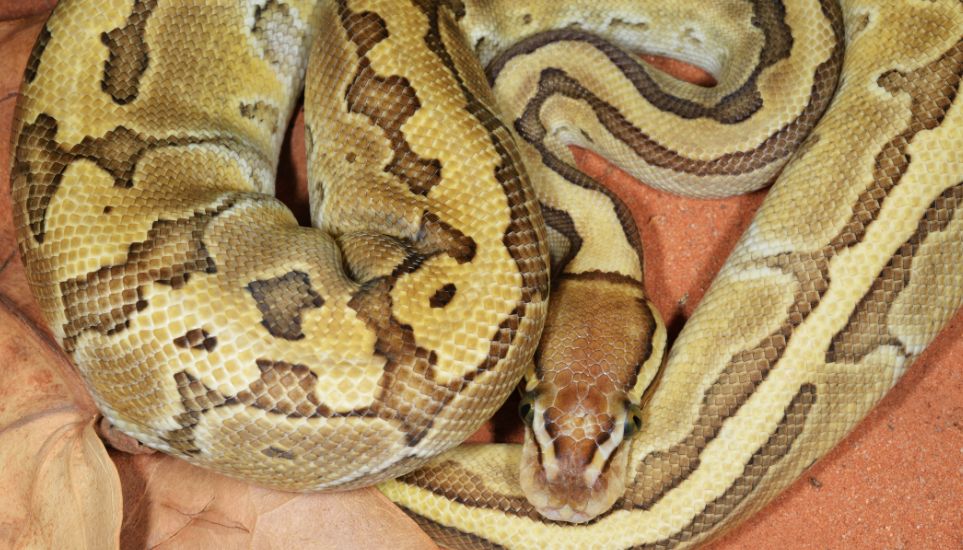Welcome, fellow snake enthusiasts! Today we’re diving deep into a topic that’s on the mind of every blood python owner—can these magnificent creatures be kept together?
The answer is a bit of a mixed bag. Technically, yes, blood pythons can be kept together, but it’s not always recommended. Blood pythons are known for their ‘sassy’ nature and can be territorial, which could lead to aggression.
Plus, there’s a risk of disease transmission. If you’re considering cohabiting blood pythons, it requires meticulous planning. You’ll need a spacious enclosure, multiple hiding spots, and constant monitoring, especially during the introduction phase.
Always consult a vet and be prepared with a backup plan in case things don’t work out.
We’ll explore the why’s and why-not’s, dissecting the pros and cons, and laying down some general guidelines for those brave souls willing to venture into the world of snake cohabitation.
Plus, we’ll look at alternative housing options and answer some FAQs to give you a holistic view. Buckle up; it’s going to be a slithering good read!

Table of Contents
Why Would You Want to Keep Multiple Blood Pythons Together?
Ah, blood pythons! They’re like the brooding rebels of the snake world, aren’t they? Gorgeous, intriguing, but oh-so-misunderstood. Now, let’s tackle the million-dollar question: “Can blood pythons be kept together?”
First off, why would anyone want to keep multiple blood pythons together in the first place? There are a couple of compelling reasons.
Firstly, let’s talk about efficiency. If you’re already the proud owner of one of these magnificent serpents, you know that snake-keeping is no small endeavor. There’s the enclosure, the heat lamps, the food—oh, don’t get me started on the food.
So, having two snakes in one space can be a matter of convenience and efficiency. You’re essentially doubling up on your ‘snake joy’ without doubling up on the resources.
Then there’s the aesthetic factor. Imagine walking into a room and being greeted by an enclosure featuring not one, but two beautifully coiled blood pythons. It’s like a live painting that’s constantly changing—a real conversation starter!
Plus, for some, there’s the allure of possibly breeding them, although that’s a whole different kettle of fish—or should I say, a whole different basket of eggs?
But before you jump the gun and introduce your lone snake to a new roommate, let’s dig into the guidelines you should follow.
General Guidelines for Keeping Snakes Together
Alright, I know you’re excited about the possibility of a ‘snake community,’ but slow down there, cowboy! Keeping multiple snakes together isn’t a decision to be made lightly. In fact, there are some general guidelines to consider for the well-being of your slithery friends.
Health Checks are Crucial
First and foremost, you need to make sure that both (or all) snakes are healthy. Even if they look fine to your untrained eye, a trip to the vet for a comprehensive health check is non-negotiable. You don’t want one snake passing on any diseases to another.
Equal Opportunities, Equal Sizes
Size matters—in this case, at least. You should aim to house snakes of similar size together. The last thing you want is a David and Goliath situation where one snake intimidates, or even worse, tries to eat the other!
What About the Food?
Feeding time can be a challenge when keeping multiple snakes together. It’s often advised to separate the snakes during feeding to avoid any competition or stress. Trust me; you don’t want to witness a snake version of ‘Hunger Games.’
Monitor, Monitor, Monitor!
If you do decide to go down this route, monitoring behavior is key. Watch out for any signs of stress or aggression, such as hissing, striking, or avoidance behavior. Snakes aren’t exactly expressive creatures, but these signs are their way of saying, “Hey, I’m not okay with this living situation!”
Environmental Enrichment
Lastly, make sure the enclosure is adequately enriched to provide both snakes with hiding spots and basking areas. You want to minimize stress by allowing them their own ‘personal space’ within the shared environment.
Pros of Keeping Blood Pythons Together
Alright, so you’re still with me, which means you’re serious about this whole cohabitation thing. And why not? There are some pretty tantalizing pros to keeping your blood pythons together, so let’s dive into those.
Double the Fun, Half the Hassle
First off, let’s address the obvious: two snakes in one enclosure means you only have to clean and maintain one habitat. It’s kind of like having roommates; sharing the responsibilities makes things easier on everyone. Well, easier on you at least, but hopefully easier on the snakes too if they get along.
A Picture is Worth a Thousand Words
We’ve touched on this before, but having multiple blood pythons coiled and slithering in one space is, without a doubt, a visual treat. The colors, the patterns— it’s like living art that can captivate and intrigue. This can be especially interesting if you have blood pythons with different morphs, giving you a beautiful palette of nature’s designs.
Convenience of Monitoring
Monitoring multiple snakes individually can be a chore. But when they’re in the same enclosure, you can observe their behavior, activity levels, and even health more conveniently. A win-win, right?
Potential Breeding Opportunities
If you’re into snake breeding (and let’s be real, it’s a fascinating process), having a male and female in the same enclosure can offer easier breeding opportunities. Just remember, this should be done thoughtfully, and only after consulting with a vet or snake-breeding expert.
Cons of Keeping Blood Pythons Together
But wait, pump the brakes! Because for all the advantages, there are some pretty significant drawbacks to consider. Let’s not jump into this without being fully informed.
The Aggression Factor
Blood pythons are known for their ‘sassy’ nature. Aggression can be a real issue, especially if both snakes are competing for the same resources, like a favorite basking spot or hiding area. You’d hate to have a snake duel on your hands.
Disease Transmission
One sick snake can easily turn into two sick snakes if they’re sharing the same space. Respiratory infections, parasites, you name it—diseases can spread like wildfire in close quarters.
Feeding Time Frenzy
I wasn’t joking when I mentioned the ‘Hunger Games’ scenario. Feeding time can get complicated, with potential for fights or stress. And stress in snakes can lead to health problems down the line.
The Big Unknown: Individual Behavior
Here’s the wildcard: snakes, like people, have their own personalities and temperaments. While one pair of blood pythons may get along just fine, another pair might despise each other from the get-go. The uncertainty of individual behavior is always a gamble.
What to Do If You Decide to Cohabit Blood Pythons
Okay, if you’ve reached this point, you’re probably leaning towards giving cohabitation a shot. Who could blame you? It’s an enticing concept.
But before you go playing matchmaker, let’s go through some steps to ensure you’re setting up a harmonious household—or at least, as harmonious as a snake household can be.
Vet Check-ups: A Must-Do
Both snakes need a clean bill of health. This isn’t just a recommendation; it’s an absolute must. Visit your vet to make sure neither of your slithery roommates is carrying any diseases that could be passed on.
Preparing the Habitat
Your enclosure should be set up in a way that minimizes competition. That means multiple hiding spots, multiple basking areas, and enough space for both snakes to roam freely.
The Introduction Phase
When you first introduce your blood pythons to each other, do so in a neutral setting. This could be a separate enclosure or a cleaned-out version of their future shared home. Keep the first meeting short and observe their behaviors closely. Any hissing or striking? That’s a red flag.
Monitor, Monitor, Then Monitor Some More
The first few days are crucial. Keep a close eye on how they’re interacting. You’ll want to watch out for signs of stress or aggression and be prepared to separate them immediately if things go south.
Have a Backup Plan
Always be prepared to separate your snakes if cohabitation doesn’t work out. Whether it’s another enclosure or a temporary housing solution, have a backup ready. Trust me, it’s better to be safe than sorry.
Potential Alternatives to Cohabitation
Now, maybe you’re having second thoughts about cohabitation, or maybe you’ve tried it and it just didn’t work out. No worries! There are alternatives that can still make your life as a multiple-blood-python owner more convenient.
Divided Enclosures
Some snake enclosures come with dividers, effectively giving each snake its own separate living space while still allowing you to maintain a single habitat. It’s kind of like a duplex for snakes!
Rotational Housing
If you’ve got multiple enclosures but limited space, consider a rotational housing system. Snake A spends one week in Enclosure 1, while Snake B chills in Enclosure 2. The next week, you switch them. It’s a bit more work but can reduce the risk of stress or disease transmission.
Time-Sharing the Playground
You could also allow the snakes to roam in a common area one at a time, offering them some environmental enrichment without the risk of them cohabiting full-time.
Conclusion
In this comprehensive guide, you’ve learned the intricate details of whether blood pythons can be kept together.
While it’s possible under certain conditions, it comes with its own set of challenges, including the risk of aggression and disease transmission.
But hey, armed with the right information and a carefully thought-out plan, you’re now better equipped to make the best decision for your slithery friends.
Whether you opt for cohabitation or choose one of the alternatives, remember that the key to happy snake ownership is always being flexible and informed.
So go ahead, embrace the adventure of snake keeping—you’ve got this!
FAQ
Let’s tackle some of the most commonly asked questions about blood pythons to give you a well-rounded view.
How much space does a blood python need?
Here’s the deal: Blood pythons might be on the shorter side compared to other pythons, but they’re chunky fellows. An adult blood python should have at least an enclosure that’s 4 feet long, 2 feet wide, and 1 to 2 feet high. Remember, the key word here is ‘at least.’ More space? Even better.
What is the best enclosure for a blood python?
Glass tanks are popular, but they can be a pain to maintain the proper temperature and humidity levels. A PVC enclosure or even a plastic storage box with ventilation holes can work wonders for maintaining the microclimate that your blood python needs. Just make sure it’s secure—these guys are escape artists!
Are blood pythons hard to care for?
“Hard” is relative. If you’re new to snake ownership, there might be a bit of a learning curve. Blood pythons require a specific humidity range, temperature gradient, and diet. But with some research and regular maintenance, taking care of a blood python is totally manageable. And hey, you’ve got this article as a starting point, so you’re already ahead of the game!




0 Comments